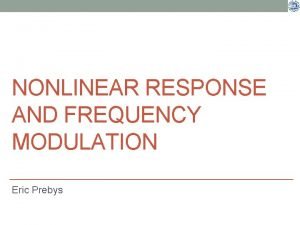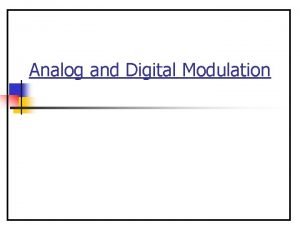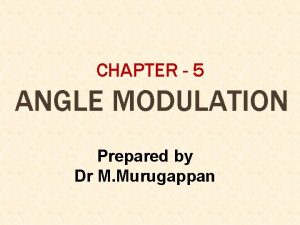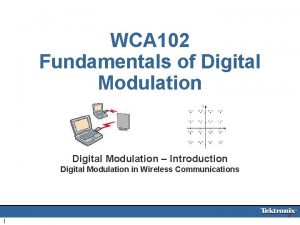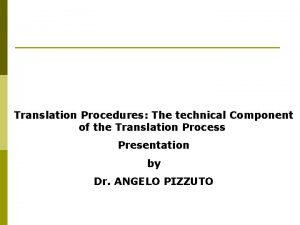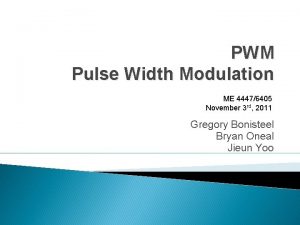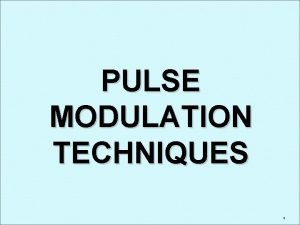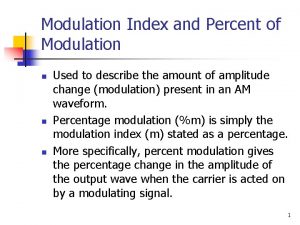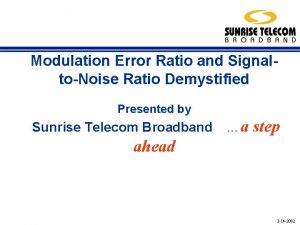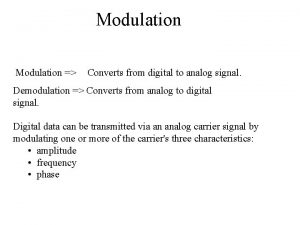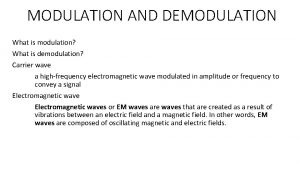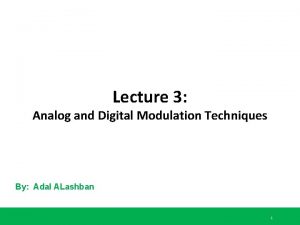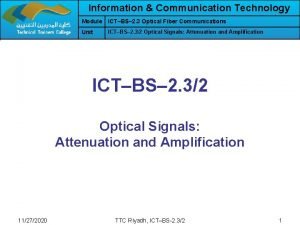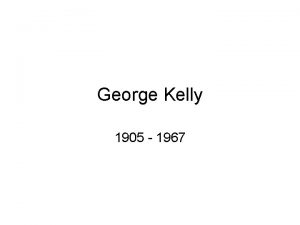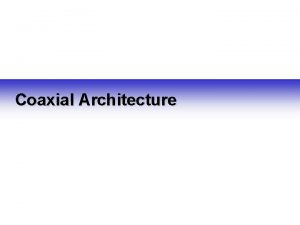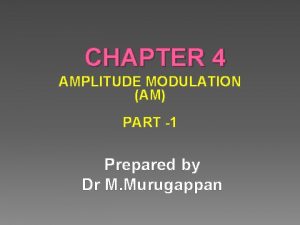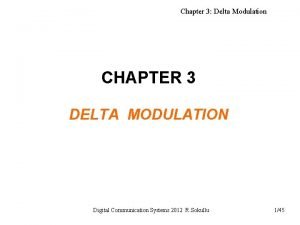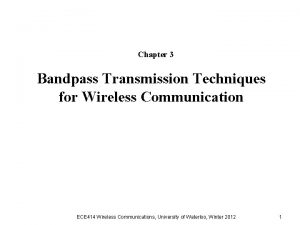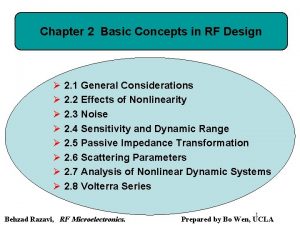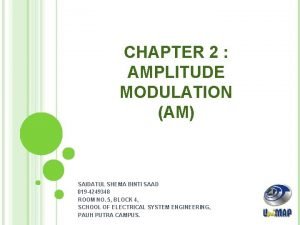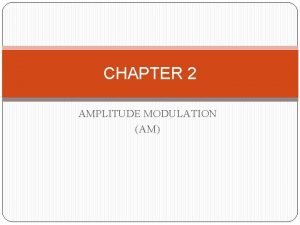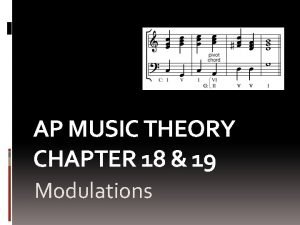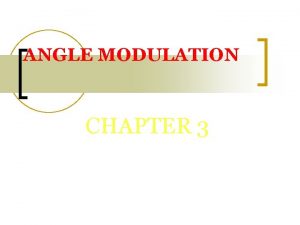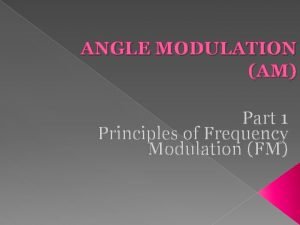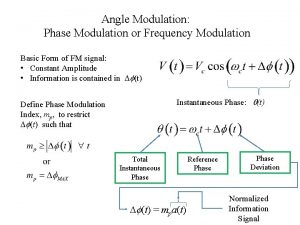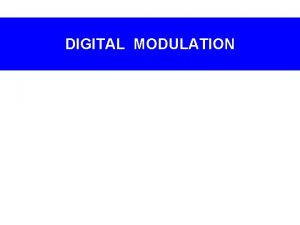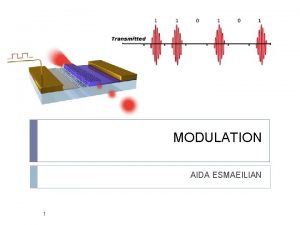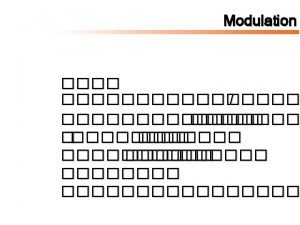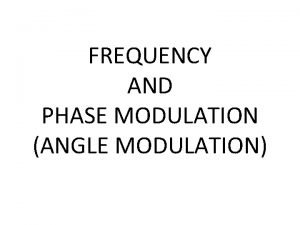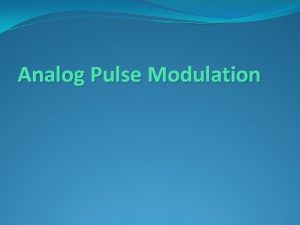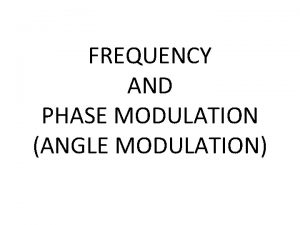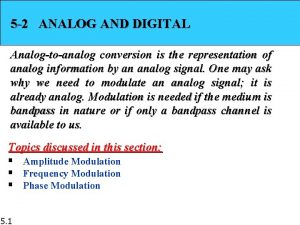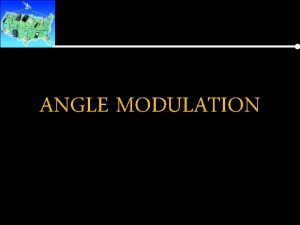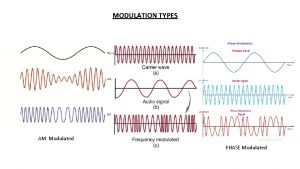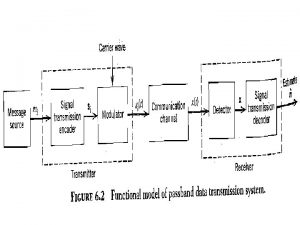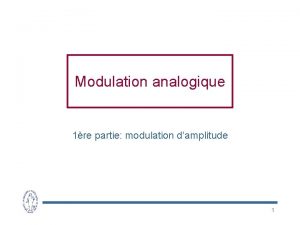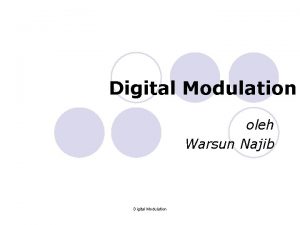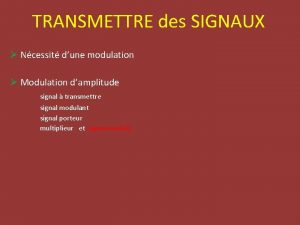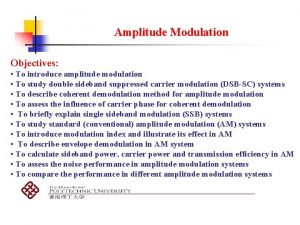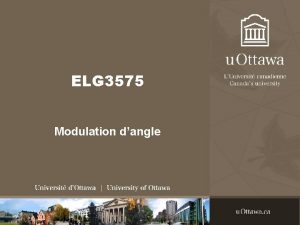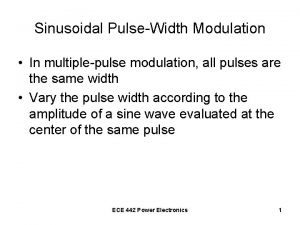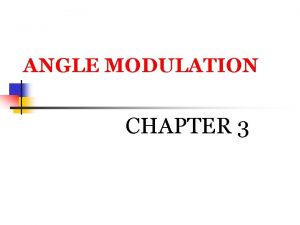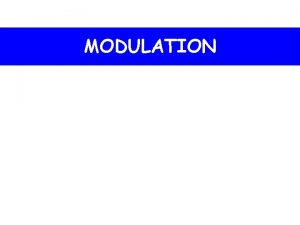Figure 5 25 Types of analogtoanalog modulation Figure

































- Slides: 33

Figure 5. 25 Types of analog-to-analog modulation

Figure 5. 26 Amplitude modulation

Figure 5. 29 Frequency modulation

Modulation och demodulation • Baudrate = antal symboler per sekund. Enhet: baud eller symboler/sekund. • Bitrate = datahastighet. Enhet: bps eller bit/s. • Vid många modulationsformer t. ex. s. k. ASK, PSK, och QAM är signalens bandbredd = symbolhastigheten. • Vid FSK är bandbredden vanligen större.

Digitala modulationsmetoder Binär signal ASK = Amplitude Shift Keying (AM) FSK = Frequency Shift Keying (FM) PSK = Phase Shift Keying (PSK)

Exempel 1: Till höger visas fyra symboler som används av ett s. k. 4 PSKmodem (PSK=Phase Shift Keying). De fyra symbolerna representerar bitföljderna 00, 01, 11 resp 10. a) Nedan visas utsignalen från det sändande modemet. Vilket meddelande, dvs vilken bitsekvens, överförs? 1 0 -1 1 Svar: 1/1 ms = 1000 symber per sekund = 1 kbaud. c) Vad är bithastigheten i bit per sekund (bps)? Svar: 2000 bps. 0 0. 5 1 time [milliseconds] 01 0 -1 Svar: 11 00 10 10. b) Tidsaxeln är graderad i tusendels sekunder. Vad är symbolhastigheten i baud eller symboler/sekund? 00 1 0 0. 5 1 time [milliseconds] 11 0 -1 1 0 0. 5 1 time [milliseconds] 10 0 -1 0 0. 5 1 time [milliseconds]

Exempel 2: Nedan visas åtta symboler som används av ett s. k. 8 QAM-modem (QAM=Quadrature Amplitude Modulation). Symbolerna i övre raden representerar bitföljderna 000, 001, 011 resp 010 (från vänster till höger). Undre raden representerar 100, 101, 111 resp 110.

Forts exempel 2:

Example 1 An analog signal carries 4 bits in each signal unit. If 1000 signal units are sent per second, find the baud rate and the bit rate Solution Baud rate = 1000 bauds per second (baud/s) Bit rate = 1000 x 4 = 4000 bps

Figure 5. 4 Relationship between baud rate and bandwidth in ASK

Figure 5. 3 ASK

Example 3 Find the minimum bandwidth for an ASK signal transmitting at 2000 bps. The transmission mode is halfduplex. Solution In ASK the baud rate and bit rate are the same. The baud rate is therefore 2000. An ASK signal requires a minimum bandwidth equal to its baud rate. Therefore, the minimum bandwidth is 2000 Hz.

Example 4 Given a bandwidth of 5000 Hz for an ASK signal, what are the baud rate and bit rate? Solution In ASK the baud rate is the same as the bandwidth, which means the baud rate is 5000. But because the baud rate and the bit rate are also the same for ASK, the bit rate is 5000 bps.

Example 6 Find the minimum bandwidth for an FSK signal transmitting at 2000 bps. Transmission is in half-duplex mode, and the carriers are separated by 3000 Hz. Solution For FSK BW = baud rate + fc 1 - fc 0 BW = bit rate + fc 1 - fc 0 = 2000 + 3000 = 5000 Hz

Example 7 Find the maximum bit rates for an FSK signal if the bandwidth of the medium is 12, 000 Hz and the difference between the two carriers is 2000 Hz. Transmission is in full-duplex mode. Solution Because the transmission is full duplex, only 6000 Hz is allocated for each direction. BW = baud rate + fc 1 - fc 0 Baud rate = BW - (fc 1 - fc 0 ) = 6000 - 2000 = 4000 But because the baud rate is the same as the bit rate, the bit rate is 4000 bps.

Figure 5. 8 PSK

Figure 5. 5 Solution to Example 5

Figure 5. 6 FSK

Figure 5. 9 PSK constellation

Figure 5. 10 The 4 -PSK method

Figure 5. 11 The 4 -PSK characteristics

Figure 5. 12 The 8 -PSK characteristics

Figure 5. 13 Relationship between baud rate and bandwidth in PSK

Example 9 Given a bandwidth of 5000 Hz for an 8 -PSK signal, what are the baud rate and bit rate? Solution For PSK the baud rate is the same as the bandwidth, which means the baud rate is 5000. But in 8 -PSK the bit rate is 3 times the baud rate, so the bit rate is 15, 000 bps.

Note: Quadrature amplitude modulation is a combination of ASK and PSK so that a maximum contrast between each signal unit (bit, dibit, tribit, and so on) is achieved.

Figure 5. 14 The 4 -QAM and 8 -QAM constellations

Figure 5. 15 Time domain for an 8 -QAM signal

Figure 5. 16 16 -QAM constellations

Figure 5. 17 Bit and baud

Table 5. 1 Bit and baud rate comparison Modulation Units Bits/Baud rate Bit Rate Bit 1 N N 4 -PSK, 4 -QAM Dibit 2 N 2 N 8 -PSK, 8 -QAM Tribit 3 N 3 N 16 -QAM Quadbit 4 N 4 N 32 -QAM Pentabit 5 N 5 N 64 -QAM Hexabit 6 N 6 N 128 -QAM Septabit 7 N 7 N 256 -QAM Octabit 8 N 8 N ASK, FSK, 2 -PSK

Example 10 A constellation diagram consists of eight equally spaced points on a circle. If the bit rate is 4800 bps, what is the baud rate? Solution The constellation indicates 8 -PSK with the points 45 degrees apart. Since 23 = 8, 3 bits are transmitted with each signal unit. Therefore, the baud rate is 4800 / 3 = 1600 baud

Example 11 Compute the bit rate for a 1000 -baud 16 -QAM signal. Solution A 16 -QAM signal has 4 bits per signal unit since log 216 = 4. Thus, 1000· 4 = 4000 bps

Example 12 Compute the baud rate for a 72, 000 -bps 64 -QAM signal. Solution A 64 -QAM signal has 6 bits per signal unit since log 2 64 = 6. Thus, 72000 / 6 = 12, 000 baud
 Amplitude modulation vs frequency modulation
Amplitude modulation vs frequency modulation Amplitude modulation vs frequency modulation
Amplitude modulation vs frequency modulation Advantages of angle modulation over amplitude modulation
Advantages of angle modulation over amplitude modulation Wct+
Wct+ Digital modulation advantages
Digital modulation advantages Translation modulation
Translation modulation Tina champagne
Tina champagne Trail edge modulation
Trail edge modulation Granular noise occurs when
Granular noise occurs when What is percentage modulation
What is percentage modulation Meruuu
Meruuu Modulation digital to analog
Modulation digital to analog Frequency modulation and demodulation theory
Frequency modulation and demodulation theory Translation und rotation sport beispiel
Translation und rotation sport beispiel Digital to analog modulation techniques
Digital to analog modulation techniques Onu
Onu Direct modulation
Direct modulation Ssin-802
Ssin-802 Commonality corollary example
Commonality corollary example Ask modulation constellation diagram
Ask modulation constellation diagram Hfc trunks
Hfc trunks Ask modulation constellation diagram
Ask modulation constellation diagram Trapezoidal pattern am modulation
Trapezoidal pattern am modulation Noise in analog modulation
Noise in analog modulation Delta modulation conclusion
Delta modulation conclusion Ask modulation constellation diagram
Ask modulation constellation diagram Rf circuit design ppt
Rf circuit design ppt Modulation envelope
Modulation envelope Principle of amplitude modulation
Principle of amplitude modulation Sequential modulation
Sequential modulation Angle modulation formula
Angle modulation formula Formula for modulation index
Formula for modulation index Single tone modulation
Single tone modulation Modulation of severn suzuki speech
Modulation of severn suzuki speech
